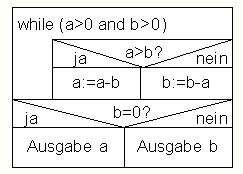 It is well known that any
algorithm can be reformulated such that only very few control structures are
needed. Structured programming and the well known Nassi-Shneidermann
diagrams provides a solution to this
problem. One can then use this structure to create algorithms made of
components with very simple sequential flow of control: simply take each
sub-block of the while-do-loops or if-then-else-conditions as a separate
program residing in a different micro-controller.
It is well known that any
algorithm can be reformulated such that only very few control structures are
needed. Structured programming and the well known Nassi-Shneidermann
diagrams provides a solution to this
problem. One can then use this structure to create algorithms made of
components with very simple sequential flow of control: simply take each
sub-block of the while-do-loops or if-then-else-conditions as a separate
program residing in a different micro-controller.
The if-then-else construct
and the while-do-loop are now
transformed into special subroutine calls:
•
call_if == 0
free_working_area copy_working_area
• call_while > w_start_addr work_loop.
These instructions mean:
• call the subroutine free_working_area
(which is a micro-controller with the correponding name) only executing this
block as its program if the zero-flag of the accumulator is set. Otherwise,
call the subroutine copy_working_area (another micro-controller with that name and only
the program-code of this 'else'-block).
• correspondingly, the while-do-loop is executed as long
as the value in the accumulator is larger than the value in the register w_start_addr, calling the micro-controller work_loop.
Addressing of the different micro-controllers (i.e. their
respective names) in biochemistry boils down to attachment of molecules. This
attachment-procedure must of course be realized by a mechanism such as lock and
key recognition because a global address-space is not available. It is
reasonable that the specificity of this recognition procedure varies in the
system and depends on the specific properties of the interacting molecules.





